The residential properties
in Nayland Rd now stand on a site which began life as a Maltings
(date unknown). The owners were `Freeman - Rodwell`, there was no
connection with the Maltings in Station Hill.
. |
|
This shows the One Bell PH on the
left, in Nayland Rd looking towards the School. After demolition,
it was the car park to the Cheese Factory. When the factory finally
closed the car park was developed with modern residential properties.
The Maltings can clearly be seen on the right, opposite.
We know from local information
that it must have been in business until the 1920`s
|
 |
Sometime between the 1920`s
and 1924 the Maltings were converted and taken over by Cornard Mills.
We know from records the Chimney for the boilers was built during 1924,
not only to provide draft for the boilers but to vent the smoke away
from the village.
| It was then the main
dying and fabric finishing works for material that was knitted at
Cornard Mills. Both the Bures and Cornard sites were owned by Melsos.
The local factory here was known as the `Stour Valley Dyeworks" |
 |
For something like 30 years Chambers had a contract with the factory
to transport anthracite from the railway station to the factory (and
also the Mill) to fuel the boilers. Transport in those days was by horse
and cart.
In later years the boilers were converted to oil, happily for the residents
this brought and end to the black dense smoke and smuts which belched
from the chimney. The chimney was now redundant, but it continued in
use to vent the boilers. Shortly after the second world war the chimney
was struck by lightening. Large cracks appeared and for safety reasons
the height was lowered and metal bands fitted for support.
During the 1960`s the factory was taken over by Vyella Coates.
Suffolk and Essex Free Press
Thursday 20th February 1947
It would appear the Mill had
a scheduled power failure, possibly by Electricity Board Engineers
working outside.
This allowed them time to bring in an alternative source of
power.
The tractor would have been driving a belt driven alternator.

|
|
NEW FACTORY
|
|
|
Left:- The new factory rebuilt
after the Fire,
Right:- The new spinning looms
Daily Mail 19.01/1994
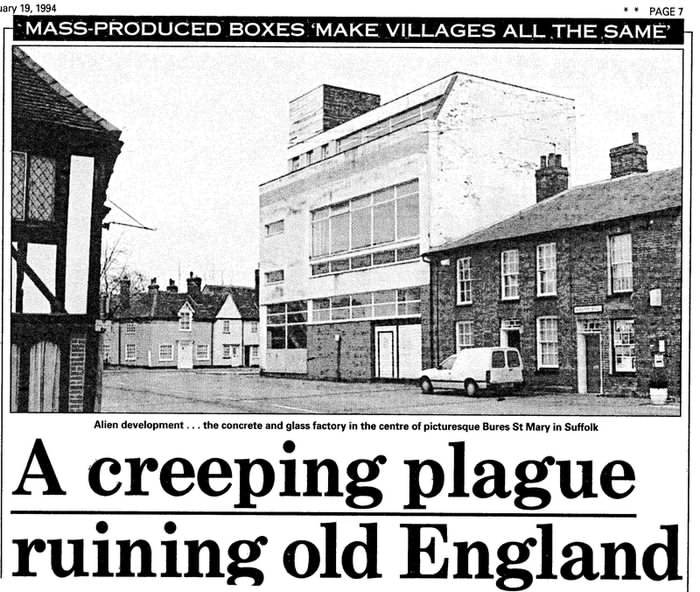
|
 This was published only
a year before it was demolished
This was published only
a year before it was demolished |
|
|
|
CKM first used a 5 ton Bedford
delivery lorry, but this was later increased to a 7 tons. This
operated on the Bures to Manchester and the Midlands twice weekly
Mon-Wed and Thurs - Fri.
Business was combined with a department of "Bradford Dyers"
Dyers in George Street, Prestwich, Manchester.
Another lorry was used on Wed - Fri to Somerset
Staff would wait for the Somerset lorries return, ready to pick
up the fresh clotted cream it collected from roadside farmshops.
(text by Allan Foote
who drove these vehicles)
|
--------------------------------------------------------------------------------------------------------------
Cornard Knitting Mills, Boilerhouse and staff
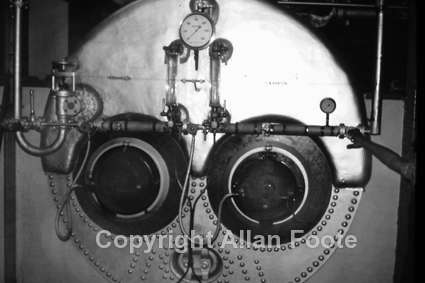
Lancashire Oil Filled Boilers
(above)
Note the oval shaped removable disc below the two fire heating
tubes. Wes Cardy and Allan Foote spent a whole summer shutdown,
inside manually descaling the fur from the boiler tubes
They both found that a wandering lamp lead when placed over
the top of a transistor radio acted an an aerial.
Music while you work, to alleviate the boredom.
|
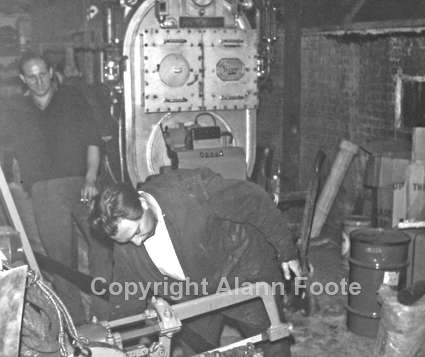 Cyril Smith ( Claypits) and Alf
from Stoke.
Cyril Smith ( Claypits) and Alf
from Stoke. |
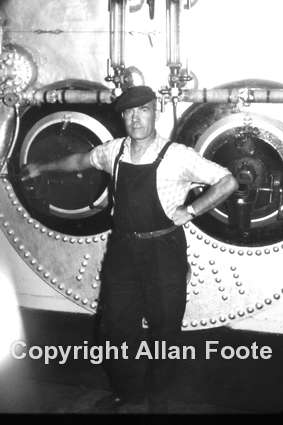
Bill, boilerman from Sudbury
|
 Cyril Smith alias "The Colonel"
Cyril Smith alias "The Colonel"
|
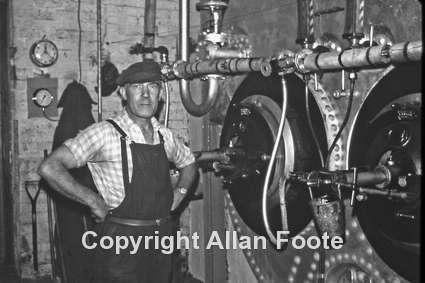 Bill, boilerman from Sudbury
Bill, boilerman from Sudbury
|
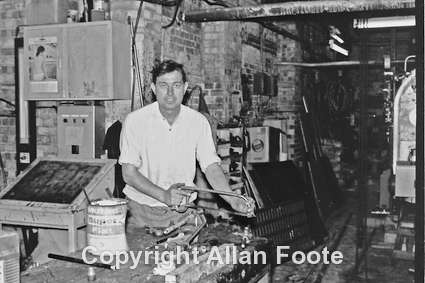 Len Suttonwood. Electrician
Len Suttonwood. Electrician |
|
DYE HOUSE:-
This had beam dying ducts, brushing machines, a cropping machine
and a hydro centrifugal drum dryer
KNITTING SHOP:- had 12 Singer circular
knitting machines making rayon, nylon and cotton fabric for brushed
terry towelling, slipper lining and car stretch seat covers
POWER:-
To the right of the Lancashire boilers was a room that housed
a steam engine driving by a large DC Generator (scrapped 1964)
operated by George Willoughby.
This powered the whole premises
and made it self contained for power. This was before the age
of 240v AC and three phase 440v AC.
The original Hydro was a gigantic DC Motor maintained by George
Willougby from the Nayland Rd.
If a Sudbury chauffeur was going to Col Stn (the car used was
a V10 Jag) to collect Joe Hyman (the Chief, see foot of page)
he would call in and warn all the male staff to get their hats
off. Joe was a strict Jew and he would sack anybody seen wearing
a hat other that a skull cap.
His other policy was to employ two me to do three mens work -
Reasonable Wages !
STAFF
Staff who worked at CKM, but do you know anymore ?
|
Denis Harris
|
Wes Cardy
|
Dave Nichols
|
Ivor Turner
|
David Vango
|
|
Percy and
Vera Street
|
Geof and
Stan Game
|
Len Mcreath
|
Lil Smith
|
Brian Bolton
|
|
Percy Johnson
|
Ted Young
|
Allan Foote
|
Fred Smith
|
|
|
|
Cornard Knitting Mills was also
operating out of property in the High Street, at the same time
as factory had been destroyed by fire.
Orange house, Left side of the entrance to the Croft
This was the administative office dealing with orders, invoices
etc
Courtesy of Heather Andrews, who
was employed there during 1964/65
|
|
During 19 ??, work was subsequently
transferred to the Manchester area and the works closed down
Memories of Bures and
the Dye Works, from Allan Foote, North Wales ( April 2013)
Before Nat. Service,
I used to work as a salesman for a fruit & veg. merchant in Colchester,
and Bures was my destination on a Monday afternoon.
The premises I am referring
to was originally an Oast House on the corner of Nayland Road.
When malting ceased the premises were changed into a dyeworks an was
named Stour Valley Dyeworks. This was purchased by a Mancunian Joe Hyman,
who also owned Melso's in Great Cornard. Joe Sold these out to Vyella
and then he in turn purchased out Vyella and it was named Vyella International
with renouned mills at Pleasley Vale and of course Vyella Fabric. The
Cornard mills was renamed Gainsborough Cornard Ltd and the Bures dyehouse
of S.V.D. was renamed Cornard Knitting Mills Ltd.
Before the fire circular knitting of rayon and nylon fabric was made
on the first floor alongside Nayland Road and was on 3 shift operation,
the dyeworks was operated on a 2 shift operation with the boiler house
operating on 2 shift with a Lancashire oil fired boiler which in turn
generated steam to drive the Direct Current generators to power the
dyehouse machines. Dyeing machines, Raising machines, Cropping machines,
and centrifugal forced spinning machines to extract the water.
After the fire a complete new factory was built on the site by a Sudbury
builder with all local labour.
Staff were bused in from Colchester and Sudbury using our own vehicles
as there was not enough suitable staff in Bures. Staff from the factory/mill
spent quite a lot of their wages in Bures at the time as for one thing
they used the Cafe opps. to 'The Swan' as a canteen at lunchtime. Parcels
were also sent out on a regular daily basis from the Goods dept. at
Bures Railway Station.
After closing down the mill was converted to a cheese factory which
eventually went into liquidation..
No2
I worked for C.K.M. till
redundancy and I am sure there are a lot of past employees who must
have some kind of contribution.
I myself was on the late shift as a CKM personel driver, and I was going
to Colchester and the fire brigade passed us at Bergholt Brewery on
the way to the disastrous fire. Somebody pushed my van out of the enclosed
yard on to the Suffolk Knoll or it would have been destroyed.
New Singer machines were in the pipeline at the time of the fire and
these were set up in Brands up at the Croft, and my mate 'Friar Tuck'
was the warehouseman.
I was employed before redundancy as a long distance driver for C.K.M.
two journeys per week and covered the Midlands but mainly Lancashire
(Manchester) and Yorkshire, delivering rolls of cloth (car seat covers,
slipper fabric) and picking up cotton/nylon yarn from manufacturers
from throughout the north.
There were a lot of people employed at CKM who were characters in their
own right.
N03
The oast house if my memory is correct had two towers/chimineys, on
the buildings alongside Nayland Road I only knew it as a Dye works.
Firstly there was a pair of big double doors on Church Square, in the
centre of the walls, then a double fronted house then the Post Office.
Then behind was a yard area with a yarn store on the left ground floor,
and the knitting shop was on the floor above it. The towers area were
used as storage for finished product, the area to the right was the
dye house which contained the dye vats, spinners, and brushing machines.
The bottom right of the yard was the boiler house, generating room and
workshop, the bottom left area was where the fin. prod. inspection area
was situated.
I nearly got the sack (severe warning) for giving a lift to two young
ladies stranded in Colchester, I was coming out of Colchester by the
Station in the C.K.M. bus about 22.40 and they were thumbing a lift
having missed the last bus. I gave them a lift back to Bures and then
they got somehow a lift to Alpheton from Bures. The next day they had
a request played for me, thanking me for the lift on 'RADIO CAROLINE'
which was played out in the knitting shop on full volume to drown the
noise of the knitting machines, for all to hear including my manager
who was not too pleased.
Note:- CKM refers to
Cornard Knitting Mills
Memories of Bures and
the Dye Works, from Dougie Dingwall, Norwich ( Dec2015)
My Godfather Fred Smith was another
member of the CKM staff. He is shown here along with his wife at the
CKM Christmas.
I believe he was a foreman there. They lived on Nayland Road opposite
Bures House, and next to the One Bell Inn, where I lived. Being four
at the time I have some vague memories of the factory fire in 1964.
We were evacuated from the pub and stayed the night with Gert &
Fred. My father Jim, elected to stay at the pub to ensure its safety
and supply the firemen with refreshments. As a large part of the pub
was of timber construction, the firemen sprayed water on it all night,
to prevent any stray burning debris setting fire to it. I remember
a few days later Fred took me to look around the burnt out factory,
my only recollection of that is the smell of smoke and the amount
of water laying around.
Fred was one of the lucky ones, when the mill eventually closed down
he was transferred to their Cornard site.
CHEESE
FACTORY
After the Knitting Mills
closed the site was sold to Swifts an American based company as a Cheese
Factory, processing waste cheese from retail outlets. Lorries from such
stores as Tesco`s, Dairy Crest etc and delivered the cheese which was
then reconstituted and resold.
A large quantity of cheese was packaged in large tins for the army as
well as cheese slices.
It employed a large number of villagers some estimating as many as about
60 employees.
Some names which were remembered:-
| Ethel Staples |
Freda Garrad |
Joyce Norris |
Bernie Clampin |
Doreen Warden |
Mable Hume |
| Pearl Cousins |
Janet Dolland |
Betty Wilkinson |
Joan Baldwyn |
Eileen Joyce |
Dick Kemp |
| Maureen Row |
Patricia Thomson |
Debbie Rickard |
|
|
|
Can you recall anymore names?
During lunchtime the "Three
Ways Cafe" over in Bridge Street was a popular venue for refreshments
It is well remembered, because of it`s very characteristic pungent smell
of boiled-up cheese, which drifted across the village!
|
|
| Front
Row |
|
|
Peter
Powell |
Peter
Felton |
| Back Row |
|
|
|
Howard Parkinson |
Can anyone put any further names to these eight Factory Workers
? |

Cheese Factory during the 1970`s |

Staff car park which stood on the site of the "One Bell PH"
1973 |

Swifts loading bay taken from
staff car park during 1973
|

Aerial View of Factory. The chimney and Bures House the the bottom
centre of the photograph can clearly be seen. |
|
|
|
1992 Cheese Factory with Steam
Hauled excursion on Railway Line.
Bures House can be seen to the left of the factory. |
Memories of the
Cheese Factory, Alan Beales
I recall visiting
the village during 1974 with my wife, to view at a property along
Cuckoo Hill which I was interested in purchasing.
Standing in the garden, my wife and myself couldnt help but notice,
the odd smell in the air
"Whatever is that" we remarked
About an hour later we called into the Post Office and asked the
lady (we now know as Angela Harrod) behind the counter "Whats
the smell" ?
I cannot recall getting a definitive
answer but she replied "What Smell"
After we moved into
our house, on many occassions when the wind was in the right direction
we had to close the windows to keep the odour of boiled cheese
outside and yes, we did get used to it after a few months.
After its closure it was left unoccupied for several years eventually
becoming an eyesore in the heart of the village. Despite many
plans for the building nothing ever materialised.
Finally in Feb 1995, the chimney was demolished and work started
on the construction of a new housing development.
|
|
|
|
|
Factory Site now
re-built as residential properties.
|
 |
Bures
House - Built 1850 by James Dalton who owned the Maltings
next door. He lived in these premises with the servants and staff
occupying the basement.
Hitchcocks (previously family of the Mill) occupied these premises
from 1875.
W.Church (founder of Church`s seeds) moved in shortly after 1913.
Photo taken 2006 |
Fire destroyed the house on 6th January
1982. More than 30 fireman fought for 2 hours to control the blaze. The
fire started in the roof and was so extensive, water was pumped by a system
of relay pumps from the River Stour. The damage to the 150 year old house
was estimated to be over £50,000.
Author:- I can recall personally returning from work in Colchester
at approximately 5.30pm and when I reached the top of Wormingford Hill
I could see the fire in the distance. It was dark at that time of the
year but the glow from the fire seemed to blanket the entire centre of
the village. A sight I can still recall to this day.
It was subsequently internally gutted and
re-built into flats with the adjacent land sold as an additional building
plot.
`Garden House` was constructed approx. 1982 and now stands on the site
of the garden and tennis courts that once belonged to Bures House.
NOTES
JOE HYMAN owner of CKM
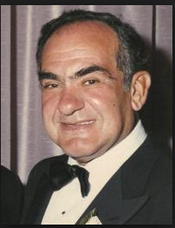 |
In the 1960s, when industrial and
managerial renaissance seemed to be reinvigorating the British economy,
Joe Hyman, was among the most vital and successful of the new men.
.
Hyman had remarkable qualities
- imagination, boldness, the ability to grasp the implications of
new technology, strong marketing sense, and a mastery of finance
that amounted to near-genius. As for the unfortunate choice of textiles,
that was an accident of birth. His grandfather and father were both
textile merchants, and Hyman left Manchester grammar school at 16
to get a start in the industry.
Working for others, even his father,
was not Hyman's style. After an early failure, he bought a small
Suffolk knitting firm in 1957, renamed it Gainsborough Fabrics at
Gt Cornard, and immediately demonstrated how new fabrics and production
methods could raise demand and bring down costs.
|
He also understood the principles of growing
by acquisition. The next buy was the Cornard Knitting Mill (Bures), followed
in 1961 by William Hollins. Unlike most of the many (too many) textile
firms of the day, Hollins possessed a national consumer brand: Viyella,
best-known for warm pyjamas.
The prime combatants, however, were
two industrial giants, ICI and Courtaulds, once partners in nylon. The
partnership degenerated into open hostility, which culminated in a celebrated
takeover battle when ICI was defeated.
So we were left with ICI and Joe Hyman
as the main textile giants
Having built his original rise on brushed
nylon, which accounted for massive shirt sales through Marks & Spencer,
Hyman was quick to see the superior potential of polyester-cotton mixtures.
ICI had pioneered the synthetic, but showed far less imagination than
its protégé when it came to commercial exploitation.
The two were ill-suited partners.
ICI was managed by career chemical engineers with little customer focus;
Viyella International, as it became, was led by a multi-talented, multi-millionaire
entrepreneur with an instinctive feel for markets.
The original cuddly, warm Viyella
brand, for example, was transformed into a fabric range that had broad,
modern appeal. Using his skills as a financial engineer, Hyman then added
other companies and brands, notably Van Heusen, as he vied with Kearton
to transform textiles into a world-beating industry.
But the effort was doomed, as was the ICI
relationship. At a celebrated, late-night board meeting in December 1969,
Hyman's underlings turned on the demanding master who had both dominated
and inspired them. Whatever part ICI played -or did not play - in the
ousting, his career as an industrial shaper and maker was over.
Joe Hyman b1921 d1999
Updated 18/04/2013
Updated 22/06/2014 new photos
Submission by Allan Foote
updated 14/03/2015
Boileroom photographs courtesy of Allan Foote
updated 15/03/2015
Complete web page re-written
updated 03/12/2015
Notes by dougie Dingwall
Updated 12/09/20
Daily Mail by Susan Ashdown
|